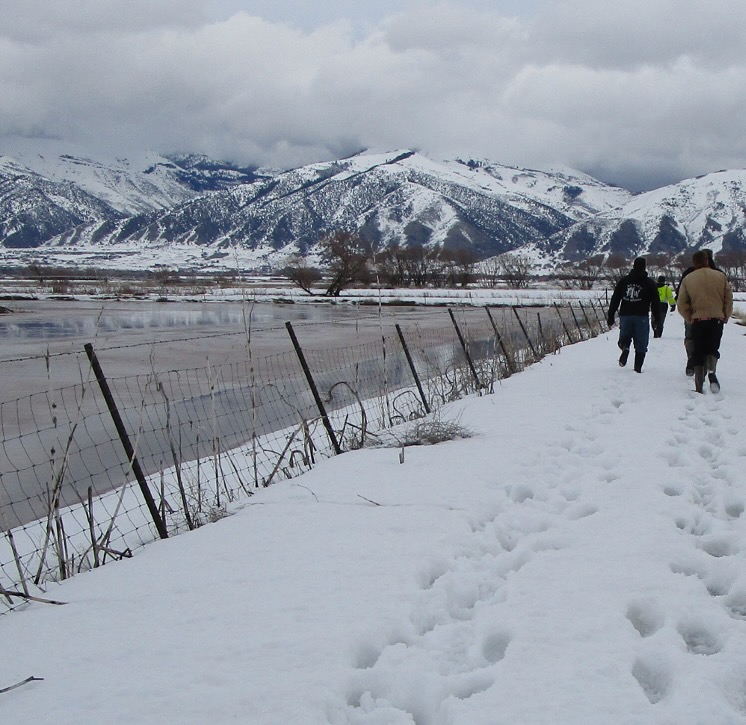Liquid Manure Storage Options During Wet, Saturated Conditions

Rapid snow melt, a wet spring, or other conditions that result in a lot of extra moisture and saturated ground can create manure storage problems for AFO/CAFOs. Options are limited when the lagoons and storage ponds are full and the ground is saturated. At this point, damage control is often the primary focus.
Key Points To Keep in Mind
- The main goal is to prevent manure and/or wastewater from getting into a water of the state.
- Avoid letting manure/wastewater enter adjacent ditches and waterbodies. For the most part, this means ensuring that manure/wastewater does not leave your property.
- If manure/wastewater leaves your property you should contact Don Hall at the Division of Water Quality (DWQ) within 24 hrs of a discharge, at 801-536-4492 or dghall@utah.gov.
Some Options if Your Lagoon is Running Out of Room
Approved Measures
- Create a short-term runoff pond or temporary holding structure to create additional storage.
- Short-term runoff ponds can be used to contain wastewater for up to 90 days.
- The wastewater should not be more than 2 feet deep.
- Short-term runoff ponds should not hold wastewater more than 90 days total in a year.
- Pump water out of the lagoon to a temporary holding structure to lower the lagoon level.
- Divert any run-on water (e.g., facility surface runoff, etc.) away from your lagoon to a temporary holding pond.
- Clean water (water that hasn’t mixed with manure/wastewater such as roof runoff) can be diverted to a water of the state.
- Use berms to prevent runoff from leaving your property. Please note, this will result in the runoff building up in some other area on your property.
Emergency Measures
- Temporary holding ponds, or containment trenches deeper than 2’.
- Use structures such as a Muscle Wall to contain water deeper than 2’.
- Plug pipes and use as temporary storage.
- Apply to fields that have berms to contain any runoff.
- If you must discharge, apply to fields that are the furthest away from streams. If possible, berm the fields on the downhill side and retain wastewater on site.
Things to Avoid
- Please note, it is important that water is removed from a lagoon prior to overtopping or breaching. If a lagoon overtops, gullies will soon form leading to large discharges of wastewater and possible dam failure.
- Any damage to a lagoon wall should be evaluated by an engineer or technical specialist for repair guidance and to ensure the lagoon is sound and can safely store wastewater.
Exemptions for Discharges
If you have an approved nutrient management plan (NMP), and are following it, then exemptions from penalties for discharges due to catastrophic weather and snow-melt events may be possible.
Who may qualify?
- Those with CAFO permits.
- Those who are enrolled in AgVIP through UDAF.
- Small and medium AFOs who have obtained an AFO Permit-by-Rule.
What needs to be done?
- Make sure you are following your NMP and have records to document that.
- Keep records of the precipitation you are getting at your farm.
- Document the efforts you have made to avoid having a discharge. Take pictures before, and after, to document conditions at your location.
- If you haven’t discharged, but may, keep Don Hall in the loop.
- If you have a discharge, you should contact Don Hall at the Division of Water Quality (DWQ) within 24 hrs of the discharge, at 801-536-4492 or dghall@utah.gov.
Ultimately, the goal is to not let manure or wastewater get to a water of the state. It is better to contain the manure or wastewater on your property (even if not exactly as the regulations would mandate) than to have a discharge.
More Information
For more information, please contact:
Rhonda Miller at 435-797-3772 or rhonda.miller@usu.edu
Hannah Freeze at 435-764-6258 or hfreeze@utah.gov
Don Hall at 801-536-4492 or dghall@utah.gov

